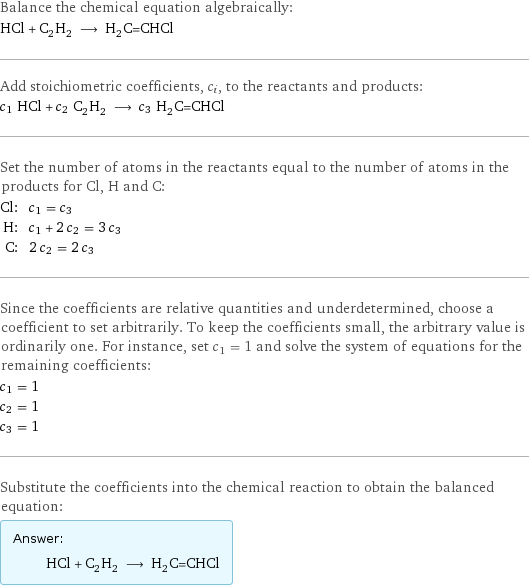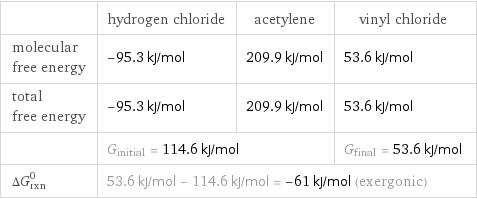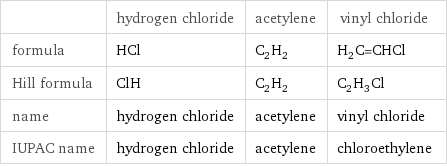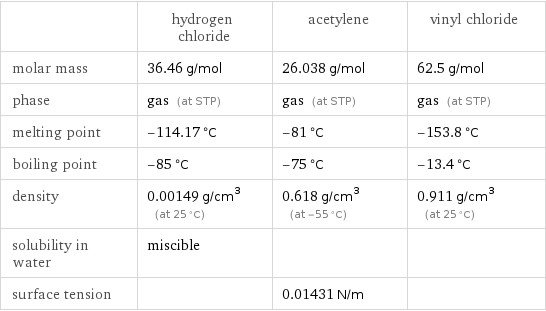Input interpretation

HCl hydrogen chloride + C_2H_2 acetylene ⟶ H_2C=CHCl vinyl chloride
Balanced equation

Balance the chemical equation algebraically: HCl + C_2H_2 ⟶ H_2C=CHCl Add stoichiometric coefficients, c_i, to the reactants and products: c_1 HCl + c_2 C_2H_2 ⟶ c_3 H_2C=CHCl Set the number of atoms in the reactants equal to the number of atoms in the products for Cl, H and C: Cl: | c_1 = c_3 H: | c_1 + 2 c_2 = 3 c_3 C: | 2 c_2 = 2 c_3 Since the coefficients are relative quantities and underdetermined, choose a coefficient to set arbitrarily. To keep the coefficients small, the arbitrary value is ordinarily one. For instance, set c_1 = 1 and solve the system of equations for the remaining coefficients: c_1 = 1 c_2 = 1 c_3 = 1 Substitute the coefficients into the chemical reaction to obtain the balanced equation: Answer: | | HCl + C_2H_2 ⟶ H_2C=CHCl
Structures

+ ⟶
Names

hydrogen chloride + acetylene ⟶ vinyl chloride
Reaction thermodynamics
Gibbs free energy

| hydrogen chloride | acetylene | vinyl chloride molecular free energy | -95.3 kJ/mol | 209.9 kJ/mol | 53.6 kJ/mol total free energy | -95.3 kJ/mol | 209.9 kJ/mol | 53.6 kJ/mol | G_initial = 114.6 kJ/mol | | G_final = 53.6 kJ/mol ΔG_rxn^0 | 53.6 kJ/mol - 114.6 kJ/mol = -61 kJ/mol (exergonic) | |
Equilibrium constant
![Construct the equilibrium constant, K, expression for: HCl + C_2H_2 ⟶ H_2C=CHCl Plan: • Balance the chemical equation. • Determine the stoichiometric numbers. • Assemble the activity expression for each chemical species. • Use the activity expressions to build the equilibrium constant expression. Write the balanced chemical equation: HCl + C_2H_2 ⟶ H_2C=CHCl Assign stoichiometric numbers, ν_i, using the stoichiometric coefficients, c_i, from the balanced chemical equation in the following manner: ν_i = -c_i for reactants and ν_i = c_i for products: chemical species | c_i | ν_i HCl | 1 | -1 C_2H_2 | 1 | -1 H_2C=CHCl | 1 | 1 Assemble the activity expressions accounting for the state of matter and ν_i: chemical species | c_i | ν_i | activity expression HCl | 1 | -1 | ([HCl])^(-1) C_2H_2 | 1 | -1 | ([C2H2])^(-1) H_2C=CHCl | 1 | 1 | [H2C=CHCl] The equilibrium constant symbol in the concentration basis is: K_c Mulitply the activity expressions to arrive at the K_c expression: Answer: | | K_c = ([HCl])^(-1) ([C2H2])^(-1) [H2C=CHCl] = ([H2C=CHCl])/([HCl] [C2H2])](../image_source/d2b173cbfe82b4a49fbbdafea3ea1826.png)
Construct the equilibrium constant, K, expression for: HCl + C_2H_2 ⟶ H_2C=CHCl Plan: • Balance the chemical equation. • Determine the stoichiometric numbers. • Assemble the activity expression for each chemical species. • Use the activity expressions to build the equilibrium constant expression. Write the balanced chemical equation: HCl + C_2H_2 ⟶ H_2C=CHCl Assign stoichiometric numbers, ν_i, using the stoichiometric coefficients, c_i, from the balanced chemical equation in the following manner: ν_i = -c_i for reactants and ν_i = c_i for products: chemical species | c_i | ν_i HCl | 1 | -1 C_2H_2 | 1 | -1 H_2C=CHCl | 1 | 1 Assemble the activity expressions accounting for the state of matter and ν_i: chemical species | c_i | ν_i | activity expression HCl | 1 | -1 | ([HCl])^(-1) C_2H_2 | 1 | -1 | ([C2H2])^(-1) H_2C=CHCl | 1 | 1 | [H2C=CHCl] The equilibrium constant symbol in the concentration basis is: K_c Mulitply the activity expressions to arrive at the K_c expression: Answer: | | K_c = ([HCl])^(-1) ([C2H2])^(-1) [H2C=CHCl] = ([H2C=CHCl])/([HCl] [C2H2])
Rate of reaction
![Construct the rate of reaction expression for: HCl + C_2H_2 ⟶ H_2C=CHCl Plan: • Balance the chemical equation. • Determine the stoichiometric numbers. • Assemble the rate term for each chemical species. • Write the rate of reaction expression. Write the balanced chemical equation: HCl + C_2H_2 ⟶ H_2C=CHCl Assign stoichiometric numbers, ν_i, using the stoichiometric coefficients, c_i, from the balanced chemical equation in the following manner: ν_i = -c_i for reactants and ν_i = c_i for products: chemical species | c_i | ν_i HCl | 1 | -1 C_2H_2 | 1 | -1 H_2C=CHCl | 1 | 1 The rate term for each chemical species, B_i, is 1/ν_i(Δ[B_i])/(Δt) where [B_i] is the amount concentration and t is time: chemical species | c_i | ν_i | rate term HCl | 1 | -1 | -(Δ[HCl])/(Δt) C_2H_2 | 1 | -1 | -(Δ[C2H2])/(Δt) H_2C=CHCl | 1 | 1 | (Δ[H2C=CHCl])/(Δt) (for infinitesimal rate of change, replace Δ with d) Set the rate terms equal to each other to arrive at the rate expression: Answer: | | rate = -(Δ[HCl])/(Δt) = -(Δ[C2H2])/(Δt) = (Δ[H2C=CHCl])/(Δt) (assuming constant volume and no accumulation of intermediates or side products)](../image_source/ce88e286565040ffdaddf7c052f41049.png)
Construct the rate of reaction expression for: HCl + C_2H_2 ⟶ H_2C=CHCl Plan: • Balance the chemical equation. • Determine the stoichiometric numbers. • Assemble the rate term for each chemical species. • Write the rate of reaction expression. Write the balanced chemical equation: HCl + C_2H_2 ⟶ H_2C=CHCl Assign stoichiometric numbers, ν_i, using the stoichiometric coefficients, c_i, from the balanced chemical equation in the following manner: ν_i = -c_i for reactants and ν_i = c_i for products: chemical species | c_i | ν_i HCl | 1 | -1 C_2H_2 | 1 | -1 H_2C=CHCl | 1 | 1 The rate term for each chemical species, B_i, is 1/ν_i(Δ[B_i])/(Δt) where [B_i] is the amount concentration and t is time: chemical species | c_i | ν_i | rate term HCl | 1 | -1 | -(Δ[HCl])/(Δt) C_2H_2 | 1 | -1 | -(Δ[C2H2])/(Δt) H_2C=CHCl | 1 | 1 | (Δ[H2C=CHCl])/(Δt) (for infinitesimal rate of change, replace Δ with d) Set the rate terms equal to each other to arrive at the rate expression: Answer: | | rate = -(Δ[HCl])/(Δt) = -(Δ[C2H2])/(Δt) = (Δ[H2C=CHCl])/(Δt) (assuming constant volume and no accumulation of intermediates or side products)
Chemical names and formulas

| hydrogen chloride | acetylene | vinyl chloride formula | HCl | C_2H_2 | H_2C=CHCl Hill formula | ClH | C_2H_2 | C_2H_3Cl name | hydrogen chloride | acetylene | vinyl chloride IUPAC name | hydrogen chloride | acetylene | chloroethylene
Substance properties

| hydrogen chloride | acetylene | vinyl chloride molar mass | 36.46 g/mol | 26.038 g/mol | 62.5 g/mol phase | gas (at STP) | gas (at STP) | gas (at STP) melting point | -114.17 °C | -81 °C | -153.8 °C boiling point | -85 °C | -75 °C | -13.4 °C density | 0.00149 g/cm^3 (at 25 °C) | 0.618 g/cm^3 (at -55 °C) | 0.911 g/cm^3 (at 25 °C) solubility in water | miscible | | surface tension | | 0.01431 N/m |
Units
